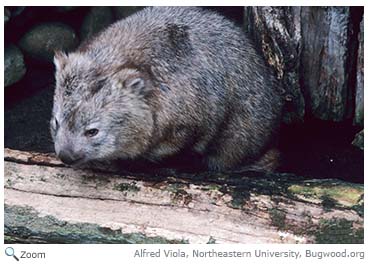 There are three species of medium to large-sized marsupials in this family. Wombats are found in Australia. There are three species of medium to large-sized marsupials in this family. Wombats are found in Australia.
Wombats are brown and have stocky bodies; short, powerful legs; short snouts; and short tails. Wombats use their strong front legs and long, strong claws to burrow into the ground. In fact, the wombat is the largest burrowing mammal.
Wombats are mostly nocturnal, but they can be active during the day. Wombats eat
grasses, herbs, leaves, roots, sedges, and bark. |
World Status Key
 Least Concern Least Concern  Near Threatened Near Threatened  Vulnerable Vulnerable  Endangered Endangered  Critically Endangered Critically Endangered  Extinct in Wild Extinct in Wild  Extinct Extinct  Data Deficient Data Deficient
Status and range is taken from ICUN Redlist.
Location Key
 Africa Africa  Asia Asia  Australia/Oceania Australia/Oceania  Europe Europe  North America North America  South America South America  NH NH  Click for More Info Click for More Info  Click for Image Click for Image
New Hampshire Species |
|
North/Central American Species |
None
|
|
None |
Species Around the World |
Northern Hairy-nosed Wombat - Lasiorhinus krefftii   
Southern Hairy-nosed Wombat - Lasiorhinus latifrons   
Common Wombat - Vombatus ursinus    
|
|
|
Additional Information
Key:  Profile Profile  Photos Photos  Video Video  Audio Audio
Common Wombat - Vombatus ursinus    
The common wombat is found in southeastern Australia and in Tasmania and on Flinders Island.
Source: Animal Diversity Web Intended Audience: General Reading Level: Middle School
Common Wombat - Vombatus ursinus    
The common wombat is nocturnal.
Source: Arkive Intended Audience: General Reading Level: Middle School
Northern Hairy-nosed Wombat - Lasiorhinus krefftii    
The northern hairy-nosed wombat is only found in the Epping Forest National Park in Queensland, Australia.
Source: Animal Diversity Web Intended Audience: General Reading Level: Middle School
Northern Hairy-nosed Wombat - Lasiorhinus krefftii     
The northern hairy-nosed wombat is the world's largest known herbivorous burrowing mammal.
Source: Arkive Intended Audience: General Reading Level: Middle School
Northern Hairy-nosed Wombat - Lasiorhinus krefftii    
There are only around 240 northern hairy-nosed wombats in the wild.
Source: Queensland Government Department of Environment and Science Intended Audience: General Reading Level: Middle School
Southern Hairy-nosed Wombat - Lasiorhinus krefftii    
The southern hairy-nosed wombat is found in southern central Australia.
Source: Animal Diversity Web Intended Audience: General Reading Level: Middle School
Southern Hairy-nosed Wombat - Lasiorhinus krefftii     
The southern hairy-nosed wombat is slightly smaller than the common wombat and the northern hairy-nosed wombat and its fur is a little redder.
Source: Arkive Intended Audience: General Reading Level: Middle School
|

